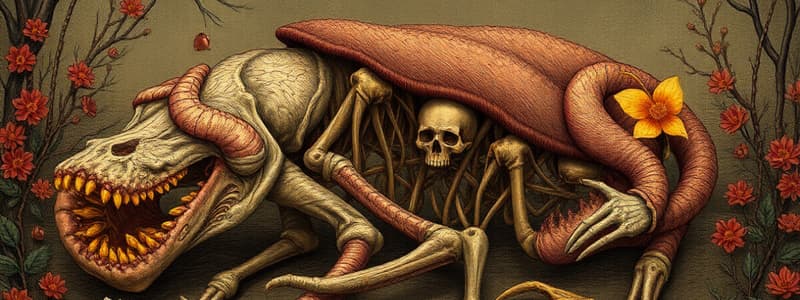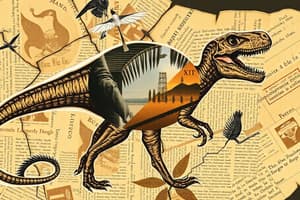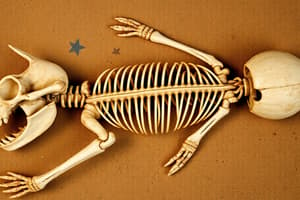Podcast
Questions and Answers
Which event marks the beginning of the taphonomic history of a bone?
Which event marks the beginning of the taphonomic history of a bone?
- The complete decomposition of soft tissues.
- The death event of the organism. (correct)
- The discovery and collection of the bone.
- The modification of the bone by environmental factors.
During which interval of taphonomic history does carnivore scavenging primarily occur?
During which interval of taphonomic history does carnivore scavenging primarily occur?
- Interval of bone modification.
- Interval of bone exposure through modification of soft tissue. (correct)
- Point of discovery and collection.
- Actual death event.
If a bone exhibits evidence of both weathering and carnivore modification, what does this suggest about its taphonomic history?
If a bone exhibits evidence of both weathering and carnivore modification, what does this suggest about its taphonomic history?
- The bone was exposed to the environment for an extended period. (correct)
- The bone was immediately collected after the death event.
- The bone was likely buried rapidly after death.
- The bone was likely protected from environmental elements.
How might the taphonomic history of a bone found in a desert environment differ from that of a bone found in a temperate forest?
How might the taphonomic history of a bone found in a desert environment differ from that of a bone found in a temperate forest?
Which of the following factors occurring post-mortem would NOT be considered part of a bone's taphonomic history?
Which of the following factors occurring post-mortem would NOT be considered part of a bone's taphonomic history?
Flashcards
Death Event
Death Event
The actual moment when the organism dies, initiating the taphonomic process.
Bone Exposure Interval
Bone Exposure Interval
The period after death where bones are exposed due to soft tissue decomposition or removal.
Bone Modification Interval
Bone Modification Interval
The phase where bones undergo alterations due to environmental, animal, or human factors.
Discovery and Collection
Discovery and Collection
Signup and view all the flashcards
Taphonomic History
Taphonomic History
Signup and view all the flashcards
Study Notes
- Taphonomic history encompasses the events that affect organic remains after death, from the initial death event to the point of discovery and collection.
Actual Death Event
- This is the starting point of taphonomic history.
- Details surrounding the death event can influence subsequent taphonomic processes.
- Cause of death, location of death, and immediate environment all play a role.
Interval of Bone Exposure Through Modification of Soft Tissue
- This stage involves the decomposition of soft tissues, which exposes the underlying bones.
- The rate of soft tissue modification is affected by various factors.
- Temperature: Higher temperatures generally accelerate decomposition.
- Humidity: Moisture levels influence microbial activity and insect colonization.
- Scavenging: Animal activity can significantly alter the remains and scatter bones.
- Insect Activity: Insects, such as flies and beetles, contribute to soft tissue removal.
- Microbial Activity: Bacteria and fungi break down organic matter.
- Burial: If the body is buried, decomposition rates can be altered depending on soil composition, depth, and oxygen availability.
- This interval is critical because the condition of the bones at this stage can influence later taphonomic modifications.
Interval of Bone Modification
- Once bones are exposed, they undergo further modifications due to various factors:
- Weathering:
- Sun exposure can cause bleaching and cracking.
- Freeze-thaw cycles can lead to exfoliation of the outer bone layers.
- Wet-dry cycles can cause warping and cracking.
- Soil Chemistry:
- Acidic soils can dissolve bone minerals, leading to degradation.
- Alkaline soils can preserve bone but may also cause surface alterations.
- Root Etching:
- Plant roots can grow on and into bones, leaving characteristic etching patterns.
- Animal Modification:
- Rodents gnaw on bones for calcium and to sharpen their teeth, leaving distinctive marks.
- Carnivores may chew on bones for marrow, causing fragmentation and punctures.
- Trampling:
- The movement of animals or humans over bones can cause breakage and scattering.
- Water Transport:
- Bones can be transported by water, leading to abrasion and dispersal.
- Fire:
- Exposure to fire can cause bones to become calcined, carbonized, or blackened, depending on the temperature and duration of exposure.
- Human Modification:
- Cut marks from butchering or dismemberment.
- Modifications from tool use.
- Intentional burial or scattering.
- The accumulation of these modifications provides insights into the postmortem history of the remains.
Point of Discovery and Collection
- This final stage marks the end of active taphonomic processes and the beginning of analysis.
- The context of discovery is crucial for interpreting the taphonomic history.
- Location: Documenting the precise location of the remains is essential.
- Position: The spatial arrangement of bones can provide clues about taphonomic events.
- Associated artifacts: Any artifacts found with the remains can offer additional context.
- Collection methods: Proper techniques are necessary to avoid damaging the remains or altering the evidence.
- Documentation: Detailed notes, photographs, and maps are essential for preserving information.
- The condition of the remains at the point of discovery reflects the cumulative effects of all previous taphonomic processes.
Studying That Suits You
Use AI to generate personalized quizzes and flashcards to suit your learning preferences.




